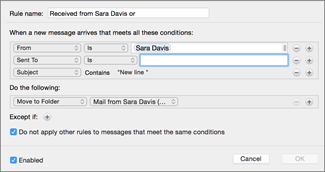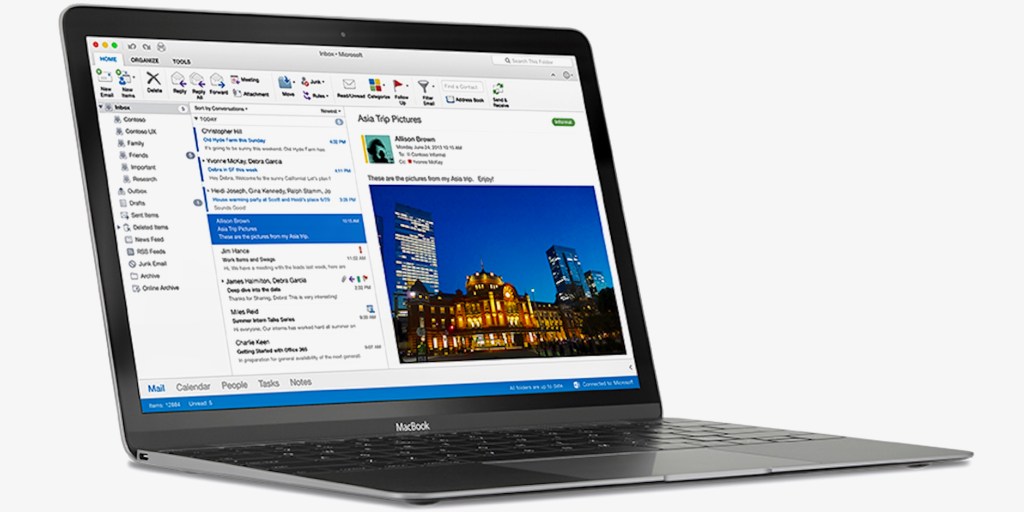Microsoft Outlook For Mac Rules
With a Microsoft Exchange account, all Outlook items are stored on the Exchange server and synchronized with Outlook at regular intervals. This allows you to access the items from another computer and to retrieve server-based copies of your items if your hard disk is damaged.
- Outlook For Macintosh
- Vue Rules Number
- Download Microsoft Outlook For Mac
- Create Rule
- Microsoft Outlook For Mac Rules 2017
Microsoft Outlook with an Office 365 subscription is the latest version of Outlook. Previous versions include Outlook 2013, Outlook 2010, and Outlook 2007. Availability of mobile apps varies by country/region. Find out what's available in your country/region. Aug 28, 2019 Identify individuals or groups of people you regularly get email from. From Outlook Mail, Actions, Rules and Alerts, create new rules for each individual group or person you regularly receive email from and direct these emails to be moved to a specific folder under the Inbox folder.
Existing Office 2016 for Mac customers will be seamlessly upgraded to 64-bit versions of Word, Excel, PowerPoint, Outlook, and OneNote as part of the August product release (version 15.25). This affects customers of all license types: Retail, Office 365. Download 64 bit microsoft word for mac pro. Microsoft word 64 bit free download - Adobe Captivate (32-bit), Adobe Captivate (64-bit), Bit Che It, and many more programs. Jun 04, 2019 Applies to: Office for Mac, Office 2019 for Mac, Office 2016 for Mac. Apple has long encouraged application developers to adopt the 64-bit runtime environment, and we've been hearing from customers that 64-bit versions of Office for Mac are desirable to enable larger address spaces, better performance, and new innovative features.
For IMAP and POP accounts, items other than email messages are stored on your computer, not on the mail server. If you use multiple account types in Outlook, such as Exchange and IMAP, you might see folders labeled 'On My Computer' in the navigation pane. The items in these folders are saved only on your computer and are not synchronized with a mail server.
- May 09, 2013 Microsoft Outlook for Mac. Category Education. Microsoft Outlook 2016 Tutorial for Beginners. Folders and Rules in Outlook 2010 for Mac - Duration.
- Microsoft Outlook provides the ability the use of rules for the way that some email is handled. Follow the steps in this topic to create rules, as needed. Complete the following steps to create a rule. Launch Outlook and then select the Rules option, located at the top of the screen. A drop-down menu displays.
- If you have a Microsoft Exchange account managed by Microsoft Exchange Server 2010 or later, the rule is automatically saved on the Exchange server. For more information, go to Outlook for Mac 2011 Help. If you create multiple rules, Outlook runs the rules in the order in which they are listed in the Rules window.
The “On My Computer” label indicates that the items in that folder are accessible only through the Outlook application, not through the Finder on your computer. Although 'On My Computer' might suggest that you can find these files by searching your computer, the label only signifies that the items in the folder are not on a mail server.
If you don't know what type of account you have

On the Tools tab, click Accounts.
In the left pane of the Accounts dialog box, click the account. The account type appears with the account description in the right pane. In the following illustration, the account is an IMAP account.
If you have an IMAP account, messages from that account sync with the IMAP server. In the mail view folder list, you will see a separate Inbox for each IMAP account.

If you have one POP account, messages are downloaded to the On My Computer Inbox. If you have multiple POP accounts, all messages from those accounts are downloaded into the same On My Computer Inbox. Because POP accounts do not allow Outlook to sync with the mail server, messages from all POP accounts go into the On My Computer Inbox. A copy of each message is downloaded into Outlook.
Note: To keep mail separate for different POP accounts, you can create rules in Outlook that automatically route your messages to folders based on the recipient address. For more information about rules, see Create a rule in Outlook 2016 for Mac.
If you have only Exchange account in Outlook, the On My Computer folders are hidden by default. This helps simplify the folder structure in the navigation pane. It can also help keep you from accidentally saving an item in a folder that is not synchronized with the Exchange server. However, you can choose to show the On My Computer folders in the navigation pane. You may want to do this, for example, if you want to create a contact group. Showing the On My Computer folders is required to create a contact group because the group does not sync with the Exchange server.
Outlook For Macintosh
Tip: To show the On My Computer folders in the navigation pane, on the Outlook menu, click Preferences. Under Personal Settings, click General, and then, under Sidebar, clear the Hide On My Computer folders check box.
To find out what type of account you have
Vue Rules Number
On the Tools menu, click Accounts.
In the left pane of the Accounts dialog box, click the account. The account type appears under the account description. In the following illustration, the account is a POP account.
If you have an IMAP account, messages from that account sync with the IMAP server. In the mail view folder list, you will see a separate Inbox for each IMAP account.
Download Microsoft Outlook For Mac
If you have one POP account, messages are downloaded to the On My Computer Inbox. If you have multiple POP accounts, all messages from those accounts are downloaded into the same On My Computer Inbox. Since POP accounts do not allow Outlook to sync with the mail server, messages from all POP accounts go into the On My Computer Inbox. A copy of each message is downloaded into Outlook.
Note: To keep mail separate for different POP accounts, you can create rules in Outlook that automatically route your messages to folders based on the recipient address. For more information about rules, see Create or edit a rule in Outlook for Mac 2011.
If you have only Exchange accounts in Outlook, the On My Computer folders are hidden by default. This helps simplify the folder structure in the navigation pane. It can also help keep you from accidentally saving an item in a folder that is not synchronized with the Exchange server. However, you can choose to show the On My Computer folders in the navigation pane. You may want to do this, for example, if you want to create a contact group. Showing the On My Computer folders is required to create a contact group because the group does not sync with the Exchange server.
To show the On My Computer folders in the navigation pane, on the Outlook menu, click Preferences. Under Personal Settings, click General. Then, under Folder list, clear the Hide On My Computer folders check box.
Create Rule
See also
Microsoft Outlook For Mac Rules 2017
What are IMAP and POP? Should link to https://support.office.com/en-US/article/What-are-IMAP-and-POP-ca2c5799-49f9-4079-aefe-ddca85d5b1c9